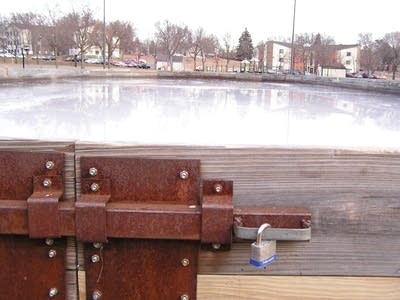Warm winters are bad news for Minnesota ice rinks
Go Deeper.
Create an account or log in to save stories.
Like this?
Thanks for liking this story! We have added it to a list of your favorite stories.

At St. Cloud's Southside Park the morning sun is just making its way over the trees along the nearby Mississippi River. City workers arrive in a truck with a 1,500-gallon water tank on its back. They gingerly maneuver the truck out onto an ice rink and two nozzles on the back of the truck spurt to life.
The truck makes it way slowly around the creaking rink, laying down a thin layer of water. When the water freezes it'll make about one-eighth of an inch of ice. Then workers will come back later to add another thin layer, slowly building up the ice rink.

This is not the way Doug Schreifels with the St. Cloud Parks Department likes to make ice. But Schreifels says with this morning's temperature just shy of freezing, slow and steady is the only way to go.
"We have to do it little by little. Usually we can drag hoses out and we can just flood this whole area. With the weather we've been having we just can't do that; it would never freeze," Shreifels says.
Turn Up Your Support
MPR News helps you turn down the noise and build shared understanding. Turn up your support for this public resource and keep trusted journalism accessible to all.
This has been a tough winter for outdoor ice rinks. Schreifels says an occasional warm-up isn't bad for ice; it melts the top layer and smooths it out. But day after day of temperatures above freezing have taken their toll on these rinks. He says they're starting to see problems usually encountered in the spring, partly because the soil underneath rinks is thawing. That causes big bumpy patches of yellow and green ice. Schriefels calls them boils.
"We usually get them on the east side of the rinks and that's just because of the sun getting the ground warm. It starts fermenting the grass and leaves laying underneath and then the boils will start. Usually we don't see those until mid-February, but we've already got them on some of our rinks now," Schreifels says.
It's been hard work to keep St. Cloud's 17 ice rinks in good shape over the last four or five years, according to Schreifels, because of warmer-than-average winters.

That's something Jon Henke has experienced too. Henke, parks director for the city of Crosslake in north central Minnesota, says conditions on the city's only ice rink in the past couple of years haven't been good. Ice making hasn't been on schedule this year either but Henke hopes to have the city rink operating soon.
"The odds aren't in our favor. We'll do whatever we can to try to create that ice for the community. That's the best that we can do, to give the community our word to go up there and give it a shot," Henke says.
Henke doesn't want city workers making ice until the weather cooperates. He says filling ice rinks and watching them melt is a waste of water, time, and taxpayer dollars.
Dan Haluptzok has a lot of experience making ice rinks, he's been with the Bemidji Parks Department since 1971. This year Haluptzok says the city's three rinks were open and in good shape early in December. But then a stretch of warm weather, even some rain, melted one of the rinks and left the other two in bad shape. Haluptzok says it hasn't been easy to build the rinks back up during this wimpy winter.

"The ideal temperature is around five below to make ice. And to finish ice you want something that's in the low 20s. There's a difference between finishing ice and building ice. Those are the two temperature ranges that we really try and look for," Haluptzok says
This winter hasn't produced those temperatures on a consistent basis. To University of Minnesota climatologist Mark Seeley, that's proof that winter doesn't carry the punch it once did.
"Our winters, more than any other season of the year, are showing strong signs of warming. Temperatures have averaged several degrees warmer than normal during the November through March period in eight of the last nine years," Seeley says.
Looking back at more than century of winters, Seeley says the last eight or so rank as the warmest ever on record.
Many researchers blame that on greenhouse gases and global warming. Seeley also says our winter air has contained more water vapor in recent years, and that has warmed overnight temperatures.
Seeley doesn't see great ice making weather ahead. He says long-range forecasts call for above-normal temperatures into February.
Dear reader,
Political debates with family or friends can get heated. But what if there was a way to handle them better?
You can learn how to have civil political conversations with our new e-book!
Download our free e-book, Talking Sense: Have Hard Political Conversations, Better, and learn how to talk without the tension.







